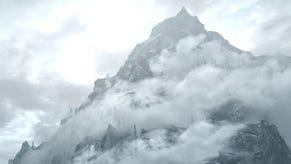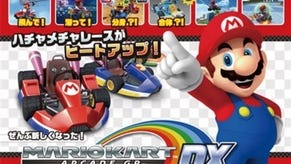Mario Kart: Double Dash!!
You're probably wondering if it's any good...
Rack your brains. Phone your mates. Ask Jeeves. Whatever. But I'd like you to try and think of a game that has created a genre and gone on to hold its head high over the competition for an entire decade. Other, that is, than Super Mario Kart. For the life of me, I simply can't. No other kart racing game beats it. Nothing before or since has managed to incorporate such a tightly and memorably constructed series of circuits, complemented them with such an addictive racing model, and then risked it all by throwing in a boatload of obscure, destructive and varied power-ups. Not Street Racer then, not Bomberman Kart now, and not even the PlayStation's rather enjoyable but generally derided Speed Freaks somewhere in-between.
And not, it has to be said, Mario Kart 64. Of all the games we knew about ahead of the N64's launch, MK64 was easily the most exciting prospect, and ultimately it's often held up as one of the most disappointing of those early titles by die-hards. Looking back at it this weekend, I realised that it's actually one of the best games I've ever played - it's just that, for me, and I would imagine rather a lot of other people, it was the sequel to the best game I've ever played. Or rather, to stave off the inevitable backlash, my favourite game.
A game of heritage
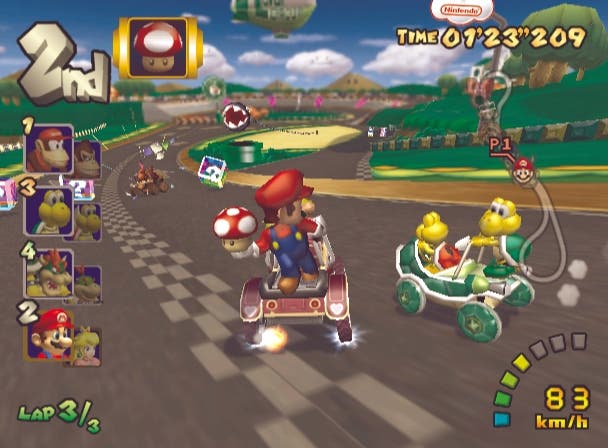
The main problem that I had (and have) with Mario Kart 64 isn't that it looks fuzzy. Most people go straight for this, but for me that was something I managed to get over. No, MK64 suffered in my eyes for two main reasons: it was 3D, and the track design was surprisingly forgettable. And it seems necessary to address these points in Mario Kart: Double Dash on two fronts: racing and battling. On the racing front, in answer to both criticisms, Mario Kart: Double Dash still relies on the ups and downs, but this time they're less gratuitous. Everyone can do 3D now, so the team behind Double Dash has been more careful, threading shortcuts up and down instead of just round the side, and, when it does give in completely and send us up, down, left, right, backwards, forwards and over the rainbow, it provides some of the most memorable gaming in years - the DK Mountain, Wario Collosseum and Rainbow Road tracks here, of which more later, are amongst the finest in MKDD, and they're about as far removed above and below from Super Mario Kart as you can possibly imagine.
Indeed, track design in Mario Kart: Double Dash is one of its biggest strengths. But it might not have been. When I first set off around Luigi Circuit - the start of the Mushroom Cup, one of three initial Grand Prix championships you can opt for - I was left with a bit of a sinking feeling, wondering if we weren't in for a repeat, a rare instance of Nintendo missing the point twice on two consecutive consoles (something it's hoping to avoid again with Mario Sunshine's successor, if I'm not mistaken). But after MKDD's fairly uncontroversial opener - a big long hillside straight raced in both directions, bookended by a pair of wide 180-degree turns lined with boost pads - things got back on the right Mario Kart track with some circuits that reprise old themes enjoyably (Peach Beach and Sherbet Land particularly will evoke some memories) and develop some new ones (Baby Park, for instance, is a manic, eight-kart, seven-lap oval track, requiring two powerslides and about ten seconds to get round that, thanks to the abundance of weapons and power-ups, quickly establishes itself as a GP favourite; while Waluigi Stadium is basically a dirt bike track with lots of jumps and a few touches of Nintendo).
Looking back after a few long days of almost non-stop playing, almost every track stands out in some way, and I would happily stick any of them on right now for a quick Time Trial, or, better yet, a four-player split-screen race with my flatmates and anybody else who might fancy a go. But if I'm forced to pick a weak link, then perhaps it's Mushroom City, a track that appeared in the original E3 demo. It recalls a similar, city-based nighttime outing in Mario Kart 64, with traffic snaking around and cutting you up if you stray too close, and various routes that weave through streets, bridges and skyscrapers. But it's my least favourite track not because of the traffic - Mushroom Bridge, another trafficy track, is actually one of the better tarmac-based offerings - but because the streets are wide, the pace is slow and the turns rather unchallenging.
Small is better

This was one of the core reasons why very few of MK64's tracks etched their place in my memory. They were big, broad and rather contrived. Take the train running through the desert - something I do remember. In retrospect, I reckon it was ludicrous inclusion! Rest assured that none of MKDD's racetracks ever throws up anything as impassable as that. Some of them will throw you off cliffs, some of them will try and bite you as you pass, some of them will even try and stamp on you, set you ablaze, flip you in the air or drown you in surf, but none of them treats you like MK64's cheating choo-choo.
And only a couple of them are as broad. For the most part, it will take a hard-earned mastery of powersliding - when to hold the shoulder button, when to release it, and when, above all, you can get away without using it - if you want to stay on the track and keep up your kart's maximum speed. Yoshi Circuit is a perfect example. I bet that nobody, not even the chap who originally penned Yoshi's memorable silhouette, ever imagined that the cheerful green dinosaur's curves and spikes would produce such a fantastic racetrack, but apparently that's what's happened. It's a cavalcade of tight bends, speedy straights and even hairpins that represents one of the best attacks of one-more-go Time Trialling of anything in Double Dash's armoury. Apart from red-headed plants snapping at you from the side of the road - and of course the overriding fact that you're racing around the exterior of a cuddly dinosaur - it does all this without resorting to Nintendo-related sentiment.
However even the tracks that do rely on the player's knowledge of Nintendo characters and games actually stand up remarkably well regardless. The abovementioned DK Mountain, for example, manages to incorporate the lush and verdant vegetation brought so memorably to life in Rare's Donkey Kong Country - barrel blasting up the side of a mountain, a creaky rope bridge and even rolling boulders - without diluting the overall feeling that you're enjoying racing the circuit and not just revelling in the novelty. After climbing up a section of hill from the start, a barrel cannon blasts you through the air, your passenger's legs flailing amusingly behind you, at 200 miles per hour, until you land at the top of a (frowning) mountain and start your bumpy descent, racing over dark grey rock, struggling vainly to keep to the lighter grey track, before segueing into a sequence of tight, unguarded, mountainous hairpin bends on grassier road, and culminating in a heart-racing sprint over a wobbly, swinging, barrier-free rope bridge and through the finish line. It's fantastic.
Steady progress
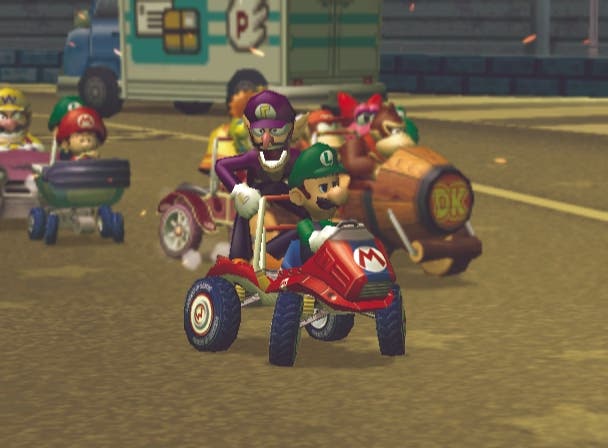
To my mind, the sixteen tracks in Mario Kart Double Dash more than wash away the painful memories (or lack thereof) drawn from Mario Kart 64. But then with that there also comes a new question: are there enough of them? The original Super Mario Kart had five tracks per cup, and four cups to race. Many of the tracks actually had second and even third iterations tucked away later in the game, and because of the way it was structured - forcing you to race the 50cc and 100cc karts through the three main cups and then defeat the freshly unlocked and much harder 150cc events before you got anywhere near the Special Cup's final five - there was countless day, nights, weekends and sick days' worth of entertainment to be soaked up, Time Trialled and sworn at profusely before you'd seen the last of them, let alone had your fill. Double Dash meanwhile has six cups, the first four made up of four tracks, a "Grand Slam" All Cup Tour challenge that has you racing 16 in a random order bookended by Luigi Circuit and Rainbow Road, and an extra "engine class", oddly, which opens all five previous cups to replay as mirrored alternatives.
Because it relies on very much the same mechanics as two major console-based predecessors - not to mention the rather excellent Game Boy Advanced-based Super Circuit, which also incorporated the SNES tracks for those skilled enough to gather 100 coins from odd spots on the track - most of the folks so eagerly waiting to get their hands on Double Dash will actually polish it off very quickly. It took me just a few hours to vanquish the 50cc, 100cc and even 150cc versions of the first three cups. In fact, I did the 150cc cups first, hoping to fast track my way to the Special Cup. No dice. With lots more championships dispatched (it may have been seven, it may have been all nine), the Special Cup opened up to me in a little under two and a half hours. I'd only played four of the MKDD tracks at trade shows beforehand, and on those occasions I'd had to queue up for hours and then sit myself in a bloody great plastic go-kart while tightly dressed hostesses distractingly talked smack with the voice of Charles Martinet about five feet away from me. So I doubt my 'advance knowledge' was all that influential here - it's just not that hard for somebody who knows and adores Mario Kart to get through the meat of Double Dash.
The Special Cup certainly asks a lot more of even the keenest karter than the first three cups. 50cc Special feels like a scouting mission - an easy way of checking out the tracks in advance of the real test to come - and predictably it falls pretty easily, and instead of pushing you too hard on the road lets you soak up the beautiful design of arguably some of the best tracks in the game. 100cc gives you a taste of what's to come, and I probably finished second on a couple of tracks here, partly because I hadn't found the right line and partly because I was still impressed by the snaking and spiralling antics of Wario Collosseum (proving that Nintendo can do F-Zero GX-style tracks really, really well), Dino Dino Jungle's dinosaurs and Bowser's menacing new Castle track. And yet even the 150cc Special Cup fell to me after three more hours of sweat, blood and profanity, unlocking the All Cup Tour and stemming a little, for me at least, the sense of 'more to come'.
Trial by star

But of course I'm still playing it. The 150cc All Cup Tour is an immense challenge and given that 150cc cups generally require the most application, and the fact that there is no "restart" option, no "you came fifth or below so you have to (and probably want to) do this again", and no lives system to fall back on, the 40 minutes or so of near-perfect racing that the 150cc All Cup Tour's demanded was actually quite a frightening prospect - even after all the Mario Karting I'd done in the past few days, and I reckon that will occupy a lot of people for quite a long time. The mirrored modes thereafter feel like a bonus, and hold the key to yet more treats and novelties.
And then there's the Time Trial mode. When I was originally playing Super Mario Kart, I would happily play those first five tracks on my own, against a ghost, against a friend or against seven other AI-controlled opponents until the sun went down. (No, actually, beyond that. The sun has no bearing on my gaming habits - I generally only stopped playing those tracks when it became physically or sanitarily necessary to, if that.) Obviously then I quickly set myself the challenge of finding out whether Double Dash Time Trial could stand up to so much repeat play. I played Yoshi Circuit, and nothing but Yoshi Circuit, for something like three hours. What do you know? It does!
Slightly more ham fisted, geriatric or fledgling gamers will need more time to get through the single-player treats on offer here, but most people will have everything rumbling happily beneath their karts and have to resort to Time Trials rather quicker than they did previously, so it's good to know the tracks stand up to this sort of rigorous exhibitionism. You can hardly fault the AI racers for failing to put up a fight elsewhere though. They give it their all on 150cc, regularly cutting you down multiple times per race with homing red shells, strategically placed banana skins and other power-ups, of which more soon, without ever cheating as much as you probably felt that Princess Peach bitch did from time to time in the older Mario Karts. They play a bit of catch-up now and again, but it doesn't seem like a bad thing when you're playing.
Still, Time Trials, a recurrent but I'm willing to bet unresearched justification for most racing games' high 'longevity' scores, are not for everyone. I'm a big fan of the track design in Double Dash, and I'll happily play around with Time Trial mode for months to come, but for those of you who won't it leaves us with just the multiplayer. All of which brings us neatly to part two of my original conundrum: does Double Dash avoid the pitfalls MK64 encountered (three dimensions and forgettable design, for those who've lost track) in the oft-imitated and highly regarded Battle mode?
The ultimate party game?

For helping prove that, yes, it does manage to do this, I owe my long-suffering flatmates Mark and Martin (and Martin's girlfriend Vicky) a great debt of thanks. Four-player Double Dash is, without a doubt, one of the best justifications for those four controller ports on the front of the GameCube that we've yet seen. Mario Kart obviously relies to a certain extent on the player's mastery of the various power-ups and their ability to avoid them - something helped this time by telltale audio clues and a little icon that appears at the bottom of the screen when you've got a homing shell or some other nastiness gaining on you like a tidal wave of pain - and Battle mode is the best place to learn this art. Thankfully, then, the arenas are mostly well designed. The Block City map is probably my favourite - a square, Tetris-inspired map with a track round the outside, split into a cross shape by chunky scenery that sits low enough for you to hurl bombs and other objects over the top as you scoot around. The others vary in quality, with the circular Cookie track working pretty well, while the top-of-a-GameCube map almost misses the point and Luigi's Mansion veers a bit too close to MK64's "we've got a third dimension and we're not afraid to use it" approach.
When you're playing Battle mode with friends - whether it's the familiar balloon mode, where each player can take three hits before he's out, and the last man standing wins; Bom-omb Blast, where all the power-ups are bombs, players can carry huge numbers of bombs and the scoring system is a bit more Quake-like; or Shine Thief mode, where players have to try and capture and hold a Shine (star) without taking a hit for a certain number of seconds to win - you'll all be sat there with an almost permanent smile lodged on your faces. You'll find new, innovative and frankly hilarious putdowns for rattled opponents ("Woman, you are the benchmark for lameness!"), you'll celebrate with arms raised high if you can crawl back to victory with just one balloon as a mass of green shells bounce endlessly around the level and your opponents roll around on the floor in shame, and you'll soon uncover all the little intricacies of the controls and particular power-ups and weapons. Even if, at the end of the day, you'll look back and reflect that Super Mario Kart's four battle mode arenas haven't really been bettered here, and probably never will be, you'll still have a lot of fun.
To expand on that last point, it seems fair to say that after a few days, Double Dash's battle offering feels a bit anorexic, with just two or three arenas that you'll come back to time and again, an inkling of the same feeling that the third dimension has been abused here for the sake of it, and the realisation that Bom-omb blast is too random and the "Shine Get" game, as it's known around here, is actually rather boring in the long run. Fortunately you've still got plenty of tracks to race endlessly around with your friends, not to mention mirrored versions, including some corkers I simply don't have the time to mention or desire to spoil, but what we're left with is simply a fantastic multiplayer game, rather than one which surpasses the purity of the original. Er, and you know you're getting picky when "fantastic" feels faintly disappointing, I guess.
New enough
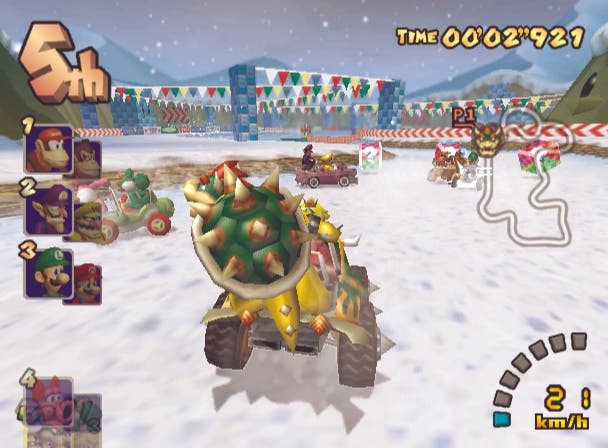
Overall though, Nintendo's Double Dash team has to be applauded on countless levels, and mainly because it has managed to clamber back into the driving seat of the genre it invented - against all the odds. It has done this not through a policy of repetition, but of reinvention. Old tracks and trackside gimmicks aren't just rehashed here, they're rethought with new references snuck into play, like the beaked and literally flipping bastards on the Peach Beach level, and there are plenty of other examples of this.
The graphical side of the game, too, is intimately familiar despite being, as a flatmate mused on Saturday evening, actually rather functional. There's no gimmick here, no Zelda-style cel-shading, just sharp, traditional cartoon graphics and rendered characters. It looks like the sort of game Rare might have made if its Diddy Kong racing update had been given more time, with intricately drawn karts, characters with endearingly individual poses, reactions and taunts, and tracks that capture the bright, warm and sharply focused feeling of Nintendo. Textures are often basic and edges often pointy rather than smooth, but there are little details that complete the warm and colourful next-generation look, like dust being kicked up, characters juggling power-ups on the back of the kart and shooting stars whooshing past the tough and often precarious Rainbow Road - a track which deserves special mention for its beautifully reflective, almost chrome-like track surface, which breathes new life into the game's most (in)famous spectacle. It's a wicked course to complete, too. In short, the game looks good, looks familiar, and hits all the right pleasure centres. Graphically it moves on without pissing on its heritage.
Likewise, the soundtrack is full of new tunes that you'll be happily whistling along to after a few hours (they're seriously infectious, in fact), instead of old safe ones, the sound effects department has been burning the midnight oil (and recording the noise) to great effect, and weapons and power-ups benefit from a few new and genius inclusions (the Bom-ombs are the best, and character-specific features like Peach's heart-shaped shield are also handy), refinements (you're no longer ringed by a handy and rather unbalancing shield of three lethal shells as you race, and can actually have items knocked or seized from your grasp by lightning bolts, sharp jolts from other racers or a shell to the bumper) and removals (no more Ghost power-up), and then of course there's the titular gimmick: the fact that each kart is now ridden by two racers.
Speed Freaks

I've been putting off mentioning this aspect of the game (and one other thing, which we'll get to in a minute) for as long as humanly possible. But after months of speculation, the 'Double Dash' element actually reveals itself as one of the best reinterpretations of the Mario Kart formula of all. Instead of just picking from eight characters, each armed with their own identikit kart, this time you have three choices to make - two characters and one kart - and the final combination is extremely significant. Choose Mario and Luigi, for example, in their kart, and you'll be racing with the same sort of feel as you would have if you picked either of them in any of the previous games. The same goes for Toad and Toadette (unlocked after a few cups, bolstering the character roster another two slots) and their kart. But if you go for a combination, you may find you achieve a better balance of stats in the Acceleration, Speed and Weight categories. With this, you're immediately given far more control over the feel of a race. The only slightly annoying thing about it all is the lack of the performance stats on the multiplayer character select screen, where perhaps it matters most.
On the track, having two characters is more for show than anything else. You can swap them at any time with the Z button, but the handling isn't noticeably different for doing so; you just get a different chap swinging his backside into every powerslide, a different set of sound effects, and a different animation when the little guy or gal has to hold or juggle power-ups, or hang on for dear life in the wake of an explosion, or while he or she is being catapulted through the air. But nonetheless there's very little to fault about this design decision and it does increase the amount of performance combinations available to you, not to mention the amount of potential unlockables sprinkled throughout the game. New karts are commonplace, and often very fetching - like the barrel train and the car from the podium sequence - but new characters are particularly pleasing, especially the two you'll unlock last.
And so, finally, we get to the thing that anybody who's already played Mario Kart: Double Dash has been silently screaming about for however long they've been reading - the speed of the game! After playing it for an hour or so at last Thursday's launch party (the place where most folks grabbed their review copies), those who went came back to me and said that it was too slow. Much too slow. They even called it "boring". Now, I think I've played Double Dash more in one weekend than a lot of you will ever play it, and the last thing I would ever say is that it's boring. In fact, I have trouble understanding why people think it's too slow, and it even makes me a little angry. I don't know whether they just played with 50cc karts the whole time (which, yes, are noticeably slower and easier to handle at top speed than their 150cc cousins) or whether they were just upset with a snatch of Karting after a week of long, hard and thoroughly draining 1300 mile-per-hour F-Zero GX. All I can say is that I simply don't think it's too slow, and think that even if you do decide it's too slow to begin with, you'll quickly forget all about that and become thoroughly absorbed in unlocking every last piece of the puzzle, and battling with your friends for many hours as a best of three becomes a best of five becomes a best of seven becomes a best of god only knows what. And the prospect of playing an All Cup Tour with one other friend (sadly Grand Prix is for one or two people only) is a new thrill even for Mario Kart die-hards. Find a similarly skilled opponent and it's like being Man United and Arsenal for half a Premiership season. Or, if you take it on co-operatively, like being Ruud and Keane.
Nine is a four-letter word
Rating Mario Kart: Double Dash is one of the hardest things I'll ever have to do, because I know that for me personally this is the one game I've always wanted to write about. A proper follow-up to Super Mario Kart - the most played game in my entire collection. The wrong score will probably haunt me for years, long after the comments thread stops kicking dirt in my face and my inbox is cleansed of vitriol. And that's why there's only one digit sat underneath this paragraph and not two. I could give it a 10 - I feel sure I could justify it to anybody stupid enough to tap me on the shoulder at a trade show or press junket and argue the point - but ultimately I'm resigned to the fact that it's not as monumental as it could be, and I know that though I may feel that way, others won't. And significantly they'll have to pay for it.
It is flawed, despite exercising the highest standards for the most part, and now, after so much backchat from my journo chums, even I'm starting to question if it couldn't do with an extra burst of speed. With more battle tracks, a few more actual racetracks and four-player Grand Prix mode - and let us not forget Internet play, for those of us who will never have all the equipment to make use that tantalising LAN mode - Double Dash would almost certainly qualify for the top score. As it is, at times it's a hair's breadth away, and you're doing yourself a massive disservice if you don't race out and buy this the second it's available.
In my opinion, it's not a better game than the original Super Mario Kart, but it is the closest anyone's ever come, and one of the finest pieces of electronic entertainment ever developed.



